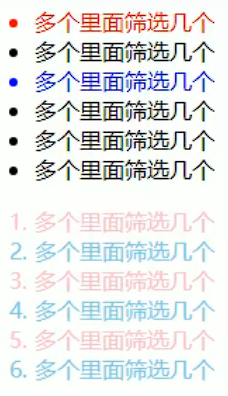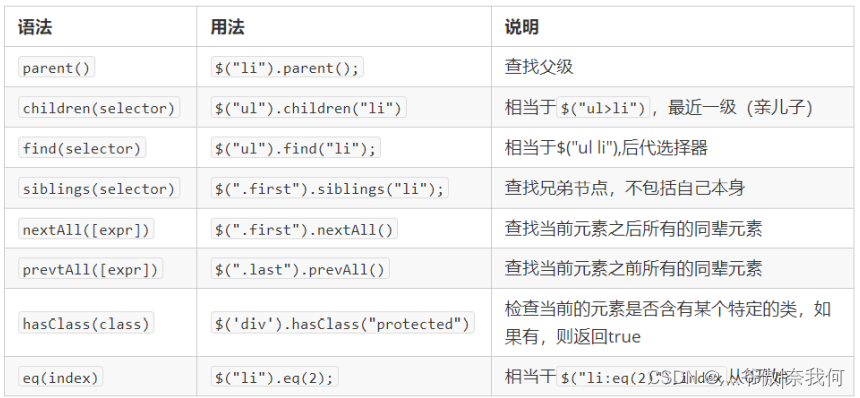jQuery常用API①(选择器、样式操作)
jQuery选择器
jQuery 基础选择器
原生 JS 获取元素方式很多,很杂,而且兼容性情况不一致,因此 jQuery 给我们做了封装,使获取元素统一标准。
$(“选择器”) // 里面选择器直接写 CSS 选择器即可,但是要加引号
- 1

jQuery层级选择器

隐式迭代
遍历内部 DOM 元素(伪数组形式存储)的过程就叫做隐式迭代。
简单理解:给匹配到的所有元素进行循环遍历,执行相应的方法,而不用我们再进行循环,简化我们的操作,方便我们调用。
例如:
jQuery 设置样式
$('div').css('属性', '值')
- 1
<body>
<div>惊喜不,意外不</div>
<div>惊喜不,意外不</div>
<div>惊喜不,意外不</div>
<div>惊喜不,意外不</div>
<ul>
<li>相同的操作</li>
<li>相同的操作</li>
<li>相同的操作</li>
</ul>
<script>
// 1. 获取四个div元素
console.log($("div"));
// 2. 给四个div设置背景颜色为粉色 jquery对象不能使用style
$("div").css("background", "pink");
// 3. 隐式迭代就是把匹配的所有元素内部进行遍历循环,给每一个元素添加css这个方法
$("ul li").css("color", "red");
</script>
</body>
- 1
- 2
- 3
- 4
- 5
- 6
- 7
- 8
- 9
- 10
- 11
- 12
- 13
- 14
- 15
- 16
- 17
- 18
- 19
- 20
jQuery 筛选选择器

例如:
<body>
<ul>
<li>多个里面筛选几个</li>
<li>多个里面筛选几个</li>
<li>多个里面筛选几个</li>
<li>多个里面筛选几个</li>
<li>多个里面筛选几个</li>
<li>多个里面筛选几个</li>
</ul>
<ol>
<li>多个里面筛选几个</li>
<li>多个里面筛选几个</li>
<li>多个里面筛选几个</li>
<li>多个里面筛选几个</li>
<li>多个里面筛选几个</li>
<li>多个里面筛选几个</li>
</ol>
<script>
$(function() {
$("ul li:first").css("color", "red");
$("ul li:eq(2)").css("color", "blue");
$("ol li:odd").css("color", "skyblue");
$("ol li:even").css("color", "pink");
})
</script>
</body>
- 1
- 2
- 3
- 4
- 5
- 6
- 7
- 8
- 9
- 10
- 11
- 12
- 13
- 14
- 15
- 16
- 17
- 18
- 19
- 20
- 21
- 22
- 23
- 24
- 25
- 26
结果:

jQuery 筛选方法

<body>
<div class="yeye">
<div class="father">
<div class="son">儿子</div>
</div>
</div>
<div class="nav">
<p>我是p1</p>
<div>
<p>我是p2</p>
</div>
</div>
<script>
// 注意一下都是方法 带括号
$(function() {
// 1. 父 parent() 返回的是 最近一级的父级元素 亲爸爸
console.log($(".son").parent());
// 2. 子
// (1) 亲儿子 children() 类似子代选择器 ul>li
// $(".nav").children("p").css("color", "red");
// (2) 可以选里面所有的孩子 包括儿子和孙子 find() 类似于后代选择器
$(".nav").find("p").css("color", "red");
});
</script>
- 1
- 2
- 3
- 4
- 5
- 6
- 7
- 8
- 9
- 10
- 11
- 12
- 13
- 14
- 15
- 16
- 17
- 18
- 19
- 20
- 21
- 22
- 23
- 24
- 25
<body>
<ol>
<li>我是ol 的li</li>
<li>我是ol 的li</li>
<li class="item">我是ol 的li</li>
<li>我是ol 的li</li>
<li>我是ol 的li</li>
<li>我是ol 的li</li>
</ol>
<ul>
<li>我是ol 的li</li>
<li>我是ol 的li</li>
<li>我是ol 的li</li>
<li>我是ol 的li</li>
<li>我是ol 的li</li>
<li>我是ol 的li</li>
</ul>
<div class="current">俺有current</div>
<div>俺木有current</div>
<script>
// 注意一下都是方法 带括号
$(function() {
// 1. 兄弟元素siblings 除了自身元素之外的所有亲兄弟
$("ol .item").siblings("li").css("color", "red");
// 2. 第n个元素
var index = 2;
// (1) 我们可以利用选择器的方式选择
// $("ul li:eq(2)").css("color", "blue");
// $("ul li:eq("+index+")").css("color", "blue");
// (2) 我们可以利用选择方法的方式选择 更推荐这种写法
// $("ul li").eq(2).css("color", "blue");
// $("ul li").eq(index).css("color", "blue");
// 3. 判断是否有某个类名
console.log($("div:first").hasClass("current"));
console.log($("div:last").hasClass("current"));
});
</script>
</body>
- 1
- 2
- 3
- 4
- 5
- 6
- 7
- 8
- 9
- 10
- 11
- 12
- 13
- 14
- 15
- 16
- 17
- 18
- 19
- 20
- 21
- 22
- 23
- 24
- 25
- 26
- 27
- 28
- 29
- 30
- 31
- 32
- 33
- 34
- 35
- 36
- 37
- 38
- 39
- 40
jQuery 里面的排他思想
想要多选一的效果,排他思想:当前元素设置样式,其余的兄弟元素清除样式。
$(this).css(“color”,”red”);
$(this).siblings(). css(“color”,””);
- 1
- 2
例如:点击一个按钮其背景颜色变化 其他的不变
<body>
<button>快速</button>
<button>快速</button>
<button>快速</button>
<button>快速</button>
<button>快速</button>
<button>快速</button>
<button>快速</button>
<script>
$(function() {
// 1. 隐式迭代 给所有的按钮都绑定了点击事件
$("button").click(function() {
console.log(this);
// 2. 当前的元素变化背景颜色
$(this).css("background", "pink");
// 3. 其余的兄弟去掉背景颜色 隐式迭代
$(this).siblings("button").css("background", "");
});
})
</script>
</body>
- 1
- 2
- 3
- 4
- 5
- 6
- 7
- 8
- 9
- 10
- 11
- 12
- 13
- 14
- 15
- 16
- 17
- 18
- 19
- 20
- 21
这里的this用$()包起来是因为,这个this是DOM对象,不是jQuery对象。可以打印出来验证。
链式编程
链式编程是为了节省代码量,看起来更优雅。
$(this).css('color', 'red').sibling().css('color', '');
- 1
使用链式编程一定注意是哪个对象执行样式.
同时还要注意方法的返回值。
例如:
<body>
我是 body 的文字
<button>快速</button>
<button>快速</button>
<button>快速</button>
<button>快速</button>
<button>快速</button>
<button>快速</button>
<button>快速</button>
<script>
$(function() {
// 1. 隐式迭代 给所有的按钮都绑定了点击事件
$("button").click(function() {
// 2. 让当前元素颜色变为红色
// $(this).css("color", "red");
// 3. 让其余的姐妹元素不变色
// $(this).siblings().css("color", "");
// 链式编程
// $(this).css("color", "red").siblings().css("color", "");
// 我的颜色为红色, 我的兄弟的颜色为空
// $(this).siblings().css('color', 'red');
// 我的兄弟变为红色 ,我本身不变颜色
$(this).siblings().parent().css('color', 'blue');
// 最后是给我的兄弟的爸爸 body 变化颜色
});
})
</script>
</body>
- 1
- 2
- 3
- 4
- 5
- 6
- 7
- 8
- 9
- 10
- 11
- 12
- 13
- 14
- 15
- 16
- 17
- 18
- 19
- 20
- 21
- 22
- 23
- 24
- 25
- 26
- 27
- 28
- 29
jQuery 样式操作
操作 css 方法
jQuery 可以使用 css 方法来修改简单元素样式; 也可以操作类,修改多个样式。
- 参数只写属性名,则是返回属性值
$(this).css(''color'');
- 1
- 参数是属性名,属性值,逗号分隔,是设置一组样式,属性必须加引号,值如果是数字可以不用跟单位和引号
$(this).css(''color'', ''red'');
- 1
- 参数可以是对象形式,方便设置多组样式。属性名和属性值用冒号隔开, 属性可以不用加引号,
$(this).css({ "color":"white","font-size":"20px"});
- 1
例如:
<body>
<div></div>
<script>
// 操作样式之css方法
$(function() {
console.log($("div").css("width"));
// $("div").css("width", "300px");
// $("div").css("width", 300);
// $("div").css(height, "300px"); 属性名一定要加引号
$("div").css({
width: 400,
height: 400,
backgroundColor: "red"
// 如果是复合属性则必须采取驼峰命名法,如果值不是数字,则需要加引号
})
})
</script>
</body>
- 1
- 2
- 3
- 4
- 5
- 6
- 7
- 8
- 9
- 10
- 11
- 12
- 13
- 14
- 15
- 16
- 17
- 18
如果是复合属性则必须采取驼峰命名法,如果值不是数字,则需要加引号
设置类样式方法
作用等同于以前的 classList,可以操作类样式, 注意操作类里面的参数不要加点。
- 添加类
$(“div”).addClass(''current'');
- 1
- 移除类
$(“div”).removeClass(''current'');
- 1
- 切换类
$(“div”).toggleClass(''current'');
- 1
切换的本质就是:有则加,无则减
类操作与className区别
原生 JS 中 className 会覆盖元素原先里面的类名。
jQuery 里面类操作只是对指定类进行操作,不影响原先的类名。
文章来源: blog.csdn.net,作者:十八岁讨厌编程,版权归原作者所有,如需转载,请联系作者。
原文链接:blog.csdn.net/zyb18507175502/article/details/123904004
- 点赞
- 收藏
- 关注作者


评论(0)